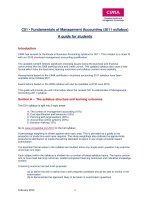McGraw hill financial analysis tools & techniques a guide for managers
Bạn đang xem bản rút gọn của tài liệu. Xem và tải ngay bản đầy đủ của tài liệu tại đây (3.38 MB, 510 trang )
AM
FL
Y
TE
Team-Fly®
hel78340_FM.qxd
9/27/01
10:56 AM
Page i
COMMENTS ABOUT ERICH A. HELFERT AND THIS BOOK
“Erich Helfert’s book is a bona fide treasury for executives, managers, and entrepreneurs
who need to understand financial management. I have used and recommended this great
work in both corporate and university programs for more than ten years. Erich Helfert possesses unique abilities to make clear the arcane that frequently enshrouds topics of financial management.”
Allen B. Barnes
Past Provost
IBM Advanced Business Institute
(formerly Director of Executive Education, UCLA)
“Erich Helfert’s book is a candidate for every consultant-to-management’s bookshelf. The
underlying agenda is financial management as it pertains to effective resource allocation decisions. Framed in a dynamic model of the Business System, the beauty of Helfert’s presentation lies in its treatment of subsystems that differentiate between investment, operations and
financing decisions, but which are also integrated into the overall managerial fabric.”
Stanley Press CMC
Book review September 2000
C2M Consulting to Management Journal
“Erich Helfert possesses a rare ability to make financial concepts understandable to individuals who lack a financial background. As a result we had Dr. Helfert conduct shareholder value
creation classes for all senior managers and create a shareholder value course for all other
salaried and hourly employees. The results of these efforts exceeded our high expectations.”
L. Pendleton Siegel
Chairman and Chief Executive Officer
Potlatch Corporation
“Erich Helfert has played an instrumental role in teaching HP managers of both financial
and non-financial backgrounds in our long-standing Functional Management Program. His
excellent financial overviews and simplified models effectively broaden our managers’
understanding and ownership of their fiscal responsibility to HP and our shareholders.”
Robert P. Wayman
Executive Vice President and
Chief Financial Officer
Hewlett-Packard Company
“Dr. Helfert’s book and his teachings go a long way toward removing the mystery from the
financial workings of an enterprise. His approach allows managers from all areas of the business to understand how their decisions impact shareholder value.”
Stephen E. Frank
President and Chief Operating Officer
Southern California Edison
“Erich Helfert has contributed to the development of financial skills of TRW managers
through his case study preparation and presentations, his book Techniques of Financial
Analysis, and his instruction. He continues to be included as a highly rated faculty member
in TRW’s management development programs.”
Peter S. Hellman
Past President and Chief Operating Officer
TRW Inc.
This page intentionally left blank.
hel78340_FM.qxd
9/27/01
10:56 AM
Page iii
FINANCIAL
ANALYSIS: TOOLS
AND TECHNIQUES
A Guide for Managers
ERICH A. HELFERT, D.B.A.
McGraw-Hill
New York Chicago San Francisco
Lisbon London Madrid Mexico City Milan
New Delhi San Juan Seoul Singapore Sydney Toronto
abc
McGraw-Hill
Copyright © 2001 by The McGraw-Hill Companies. All rights reserved. Manufactured in the United States of America. Except as
permitted under the United States Copyright Act of 1976, no part of this publication may be reproduced or distributed in any form
or by any means, or stored in a database or retrieval system, without the prior written permission of the publisher.
0-07-139541-5
The material in this eBook also appears in the print version of this title: 0-07-137834-0.
All trademarks are trademarks of their respective owners. Rather than put a trademark symbol after every occurrence of a trademarked name, we use names in an editorial fashion only, and to the benefit of the trademark owner, with no intention of
infringement of the trademark. Where such designations appear in this book, they have been printed with initial caps.
McGraw-Hill eBooks are available at special quantity discounts to use as premiums and sales promotions, or for use in corporate training programs. For more information, please contact George Hoare, Special Sales, at
or (212) 904-4069.
TERMS OF USE
This is a copyrighted work and The McGraw-Hill Companies, Inc. (“McGraw-Hill”) and its licensors reserve all rights in and
to the work. Use of this work is subject to these terms. Except as permitted under the Copyright Act of 1976 and the right to
store and retrieve one copy of the work, you may not decompile, disassemble, reverse engineer, reproduce, modify, create derivative works based upon, transmit, distribute, disseminate, sell, publish or sublicense the work or any part of it without McGrawHill’s prior consent. You may use the work for your own noncommercial and personal use; any other use of the work is strictly
prohibited. Your right to use the work may be terminated if you fail to comply with these terms.
THE WORK IS PROVIDED “AS IS”. McGRAW-HILL AND ITS LICENSORS MAKE NO GUARANTEES OR WARRANTIES AS TO THE ACCURACY, ADEQUACY OR COMPLETENESS OF OR RESULTS TO BE OBTAINED FROM
USING THE WORK, INCLUDING ANY INFORMATION THAT CAN BE ACCESSED THROUGH THE WORK VIA
HYPERLINK OR OTHERWISE, AND EXPRESSLY DISCLAIM ANY WARRANTY, EXPRESS OR IMPLIED, INCLUDING BUT NOT LIMITED TO IMPLIED WARRANTIES OF MERCHANTABILITY OR FITNESS FOR A PARTICULAR
PURPOSE. McGraw-Hill and its licensors do not warrant or guarantee that the functions contained in the work will meet your
requirements or that its operation will be uninterrupted or error free. Neither McGraw-Hill nor its licensors shall be liable to you
or anyone else for any inaccuracy, error or omission, regardless of cause, in the work or for any damages resulting therefrom.
McGraw-Hill has no responsibility for the content of any information accessed through the work. Under no circumstances shall
McGraw-Hill and/or its licensors be liable for any indirect, incidental, special, punitive, consequential or similar damages that
result from the use of or inability to use the work, even if any of them has been advised of the possibility of such damages. This
limitation of liability shall apply to any claim or cause whatsoever whether such claim or cause arises in contract, tort or otherwise.
DOI: 10.1036/0071395415
hel78340_FM.qxd
9/27/01
10:56 AM
Page v
To Anne
This page intentionally left blank.
hel78340_FM.qxd
9/27/01
10:56 AM
Page vii
ABOUT THE AUTHOR
Erich A. Helfert is an internationally recognized management consultant in corporate finance, strategic planning, and executive education in financial/economic
decision making and shareholder value creation. He gained his professional experience from a combination of distinguished business and academic careers.
Dr. Helfert was vice president, corporate planning, at Crown Zellerbach Corporation, a major integrated paper and forest products company. Prior to his 20-year
corporate career, he served on the faculty of the Harvard Graduate School of Business for eight years, teaching finance and managerial economics in the MBA program, and consulting in management development and strategy with major
companies.
A native of the Sudetenland, formerly Austria, he received his BS from the
University of Nevada and earned both an MBA (with high distinction) and a DBA
(as a Ford Foundation Fellow) at the Harvard Business School. Dr. Helfert writes
and lectures extensively in his field, and his books and articles have been published in the United States and abroad. His first literary work, Valley of the
Shadow, a factual historical novel about his experiences in central Europe at the
end of World War II, was published recently.
Dr. Helfert is cofounder, chairman and CEO of Modernsoft, Inc., San Mateo, California, developers of Financial Genome, an advanced knowledge-based
financial analysis and business modeling software, which is complementary to Financial Analysis: Tools and Techniques.
vii
Copyright 2001 The McGraw-Hill Companies, Inc. Click Here for Terms of Use.
This page intentionally left blank.
hel78340_FM.qxd
9/27/01
10:56 AM
Page ix
CONTENTS
Preface
xvii
Introduction xxi
Chapter 1
The Challenge of Financial/Economic Decision-making 1
Lessons for the Millennium 2
The New Economy 2
Some Key Questions 3
The Basics Never Change 6
The Economic Manager 7
Understanding Business Economics 8
Appropriate Economic Tools 9
The Practice of Financial/Economic Analysis 10
Day to Day Decisions and Operational Planning 10
Supporting Strategy Development 11
Performance Assessment and Incentives 12
Valuation and Investor Communications 14
The Value Creating Company 15
Relevant Decision Information 15
Economic Incentives 17
Total Systems Management 18
Chapter 2
A Systems Context for Financial Management 21
A Dynamic Perspective of Business 22
Decision Context 22
The Business System 26
Investment Decisions 29
Operating Decisions 31
Financing Decisions 33
Interrelationship of Strategy and Value Creation 36
ix
Copyright 2001 The McGraw-Hill Companies, Inc. Click Here for Terms of Use.
hel78340_FM.qxd
9/27/01
10:56 AM
Page x
x
Contents
The Nature of Financial Statements 37
The Balance Sheet 38
The Income Statement 40
The Cash Flow Statement 42
The Statement of Changes in Shareholders’ (Owners’) Equity 46
The Context of Financial Analysis 50
Key Issues 55
Analytical Support 57
Chapter 3
AM
FL
Y
Managing Operating Funds 59
TE
Funds Flow Cycles 61
The Funds Cycle for Manufacturing 64
The Funds Cycle for Sales 67
The Funds Cycle for Services 69
Variability of Funds Flows 70
Growth/Decline Variations 70
Seasonal Variations 74
Cyclical Variations 75
Generalized Funds Flow Relationships 77
Interpreting Funds Flow Data 78
Funds Management and Shareholder Value 89
Cash Management 89
Working Capital Management 90
Investment Management 91
Key Issues 91
Analytical Support 93
Chapter 4
Assessment of Business Performance 95
Ratio Analysis and Performance 95
Management’s Point of View 97
Operational Analysis 98
Resource Management 107
Profitability 112
Owners’ Point of View 115
Investment Return 116
Team-Fly®
hel78340_FM.qxd
9/27/01
10:56 AM
Page xi
Contents
Disposition of Earnings 121
Market Indicators 123
Lenders’ Point of View 126
Liquidity 126
Financial Leverage 128
Debt Service 130
Ratios as a System 132
Elements of Return on Assets 133
Elements of Return on Equity 134
Integration of Financial Performance Analysis 137
Some Special Issues 139
Inventory Costing 140
Depreciation Methods 141
The Impact of Inflation 144
Key Issues 145
Analytical Support 147
Chapter 5
Projection of Financial Requirements 161
Pro Forma Financial Statements 163
Pro Forma Income Statement 164
Pro Forma Balance Sheet 167
Pro Forma Cash Flow Statement 171
Cash Budgets 174
Operating Budgets 178
Sales Budget 179
Production Budget 181
Interrelationship of Financial Projections 181
Financial Modeling 184
Sensitivity Analysis 186
Key Issues 187
Analytical Support 189
Chapter 6
Dynamics and Growth of the Business System 191
Leverage 192
Operating Leverage 193
xi
hel78340_FM.qxd
9/27/01
10:56 AM
Page xii
xii
Target Profit Analysis 202
Financial Leverage 203
Financial Growth Plans 209
Basic Financial Growth Model 210
Sustainable Growth and the Sustainable Growth Equation 214
Integrated Financial Plan 217
Key Issues 220
Analytical Support 222
Chapter 7
Cash Flows and the Time Value of Money 223
The Time Value of Money 224
Discounting, Compounding, and Equivalence 224
Components of Analysis 231
Net Investment 232
Net Operating Cash Inflows 232
Economic Life 233
Terminal (Residual) Value 233
Methods of Analysis 234
Simple Measures 234
Economic Investment Measures 237
Net Present Value 237
Present Value Payback 242
Profitability Index (BCR) 244
Internal Rate of Return (IRR, Yield) 245
Annualized Net Present Value 247
Applying Time-Adjusted Measures 250
Key Issues 250
Analytical Support 252
Chapter 8
Analysis of Investment Decisions 255
Strategic Perspective 256
Decisional Framework 259
Problem Definition 260
Nature of the Investment 261
Future Costs and Benefits 262
Contents
hel78340_FM.qxd
9/27/01
10:56 AM
Page xiii
Contents
Incremental Cash Flows 263
Relevant Accounting Data 264
Sunk Costs 265
Refinements of Investment Analysis 266
A Machine Replacement 266
Net Investment Refined 267
Operating Cash Inflows Refined 268
Unequal Economic Lives 271
Capital Additions and Recoveries 272
Analytical Framework 272
A Business Expansion 275
Mutually Exclusive Alternatives 277
Maintain versus Replace 277
Full-Fledged versus Economy Solution 279
Comparing Different Scenarios 280
Dealing with Risk and Changing Circumstances 282
Specifying Risk 283
Ranges of Estimates 284
Business Investments as Options 285
Probabilistic Simulation 287
Risk-Adjusted Return Standards 288
When to Use Investment Measures 289
Some Further Considerations 291
Leasing—A Financing Choice 291
Accelerated Depreciation 292
Inflation and Investment Analysis 292
Accuracy 293
Key Issues 293
Analytical Support 295
Chapter 9
Cost of Capital and Business Decisions 297
Decisional Context 298
Investment Decisions 298
Operating Decisions 299
Financing Decisions 300
Cost of Operating Funds 300
Cost of Long-term Debt 304
xiii
hel78340_FM.qxd
9/27/01
10:56 AM
Page xiv
xiv
Cost of Shareholders’ Equity 305
Preferred Stock 305
Common Equity 306
Weighted Cost of Capital 312
Cost Choices 312
Weighting the Proportions 313
Calculating the Weighted Cost of Capital 315
Cost of Capital and Return Standards 317
Cost of Capital as a Cutoff Rate 318
Risk Categories 319
Cost of Capital in Multibusiness Companies 321
Multiple Rate Analysis 322
Key Issues 322
Analytical Support 324
Chapter 10
Analysis of Financing Choices 325
Framework for Analysis 326
Cost of Incremental Funds 326
Risk Exposure 327
Flexibility 328
Timing 328
Control 329
The Choice 330
Techniques of Calculation 330
Current Performance 331
Long-Term Debt in the Capital Structure 332
Preferred Stock in the Capital Structure 335
Common Stock in the Capital Structure 336
Range of Earnings Chart 339
The Optimal Capital Structure 345
Some Special Forms of Financing 347
Leasing 347
Convertible Securities 350
Stock Rights 351
Warrants 352
Key Issues 352
Analytical Support 354
Contents
hel78340_FM.qxd
9/27/01
10:56 AM
Page xv
Contents
Chapter 11
Valuation and Business Performance 357
Definitions of Value 358
Economic Value 358
Market Value 359
Book Value 360
Liquidation Value 360
Breakup Value 361
Reproduction Value 361
Collateral Value 361
Assessed Value 362
Appraised Value 362
Going Concern Value 362
Shareholder Value 363
Value to the Investor 363
Bond Values 363
Preferred Stock Values 368
Common Stock Values 372
Specialized Valuation Issues 378
Rights and Warrants 378
Options 379
Business Valuation 380
Valuing the Equity 381
Valuing the Total Company 382
Using Shortcuts in Valuing an Ongoing Business 387
Key Issues 388
Analytical Support 389
Chapter 12
Managing for Shareholder Value 391
Shareholder Value Creation in Perspective 392
Evolution of Value-Based Methodologies 396
A Review of Key Measures 398
Economic Profit and CFROI 402
Creating Value in Restructuring and Combinations 411
Restructuring and Value 411
xv
hel78340_FM.qxd
9/27/01
10:56 AM
Page xvi
xvi
Contents
Combinations and Synergy 414
Combinations and Share Values 415
Integration of Value Analysis 417
Perspectives 418
Expectations 419
Time Period 419
Cash Flow Pattern 419
Ongoing Values 420
Comparables 420
Negotiations 421
Key Issues 421
Analytical Support 423
APPENDIX I
Financial Analysis Using Financial Genome
425
APPENDIX II
Glossary of Key Terms and Concepts 433
APPENDIX III
Financial Information and On-Line Sources 449
APPENDIX IV
Basic Inflation Concepts 463
APPENDIX V
Some Issues in Multinational Financial Analysis 469
INDEX 477
hel78340_FM.qxd
9/27/01
10:56 AM
Page xvii
PREFACE
This volume is an adaptation for the professional market of the most recent 10th
(“millennium”) edition of Dr. Helfert’s best-selling Techniques of Financial
Analysis, which, with more than half a million copies in print over the past 38
years, has given the student, analyst, and business executive a concise, practical,
usable, and up-to-date overview of key financial/economic analysis tools. The
presentation format has always been carefully designed to help the reader understand the linkage between management decisions and their impact on the financial
performance and the economic value of a business. This book helps the reader to
interpret financial reports, develop basic financial projections, evaluate business
investment decisions, assess the implications of financing choices, derive the
value of a business or a security, and understand the role of analysis in achieving
the goal of shareholder value creation. Every technique and measure is described
and demonstrated in the context of important underlying financial and economic
concepts, but without delving into theoretical abstraction.
A Unique Systems Approach to Financial Management
The concept that any business is essentially an integrated system of cash flows
driven by management decisions provides the book’s foundation. All analytical
tools and related financial/economic concepts are discussed within this systems
context, which reflects the three basic types of decisions made continuously by
the management of any ongoing business: investment, operating, and financing.
The materials are also structured around the viewpoints of the major parties interested in the analysis and performance of a business: managers, owners, and creditors. The book begins by providing a perspective on the recent speculative
excesses in the new economy’s “dotcom” revolution, with the argument that basic
economics and financial analysis have never changed, but only were ignored at
times. Next, the key concept of the business system and all of its relationships to
financial analysis and statements is presented in detail, from which the discussion
proceeds to explain the various techniques and concepts in a logical flow. Closure
is provided by returning to the systems concept in the final chapters on valuation
and managing for shareholder value. Within this structure, however, practicality
always remains paramount. Any issues and concepts going beyond what is essential are left to the more specialized textbooks and articles identified in the references. The systems approach is also reflected in the commercially available
Financial Genome business analysis and planning software and its accompanying
interactive templates.
xvii
Copyright 2001 The McGraw-Hill Companies, Inc. Click Here for Terms of Use.
hel78340_FM.qxd
9/27/01
10:56 AM
xviii
Page xviii
Preface
The Audience
Ever since the first edition appeared in 1963, the book has consistently maintained
a unique appeal both for students (graduate and undergraduate) and practitioners
because of its clarity and commonsense presentation. Straddling the educational
and professional markets, the book requires little if any background in finance and
accounting and provides an accessible, self-contained overview of the essential
financial management concepts and tools. Countless students have found the book
an understandable and useful guide for their studies and kept the book for ready
reference in their careers, while large numbers of professionals—whether financial practitioners or nonfinancial managers—recognized the practicality and applicability of the book’s approach to their needs and decision-making.
Originally an outgrowth of the compact technical briefing materials used in
the MBA program at the Harvard Business School, which supplement practical
case study discussion with essential background, the book has been regularly updated and modified approximately every four years. The tenth “millennium” edition reflects not only the latest practice in the use of the various financial
techniques, but also the experience gained over nine editions from the widespread
use the book has enjoyed in university finance courses, both graduate and undergraduate, and from hundreds of executive development seminars and in-company
programs in the United States, Canada, Latin America, and overseas, including
those conducted by the author in numerous Fortune 100 client companies. Frequently translated into nine foreign languages over the years, the book has transcended the confines of American business practice on which it is built, because
the way in which the analytical methods are described makes them almost universally applicable.
What’s New in this Book
The 10th edition of Techniques of Financial Analysis, on which this volume is
based, has been refined and updated while preserving the logical, integrated flow
of the materials. After setting the stage in Chapter 1, the coverage begins with an
overview of the “business system” and the key financial analysis tools, all the way
to the development of business valuation and the newly developed materials on
managing for shareholder value. The discussion of the analysis of business investments and business valuation have been expanded into two chapters each, to
provide additional insights, practical examples, and greater linkage to shareholder
value creation. The various graphics supporting the text, several of them new additions, were tested for their effectiveness in numerous executive development
programs over the past 12 years. Also, where appropriate, specific references to
spreadsheet analysis have been included and examples are presented in this readily accessible format to ease the mechanical aspects of analysis.
An entirely new feature is the optional availability of the advanced, knowledge-based financial analysis software package, Financial Genome, created by
hel78340_FM.qxd
9/27/01
10:56 AM
Preface
Page xix
xix
Modernsoft, Inc. This professional application enables the user to develop financial statements, the whole range of key financial measures, and integrated financial projections and plans, as well as ad hoc financial analyses. The patented
knowledge-based technology enables the user to readily perform these tasks from
spreadsheet data or data bases with assured internal consistency, without having
to worry about cell locations and formulas. Knowledge of financial terms, relationships, and statement structures is built in, but can be accessed and displayed
at will for enhanced understanding. The software is also accompanied by a series
of interactive templates and displays relating to many of the key exhibits of this
book, especially the core diagram of the business system. The templates are designed to enhance the learning experience by graphically illustrating the impact of
changes in assumptions and conditions. Many templates are also designed for
general use, such as break-even and present value analysis. Financial Genome is
described in detail in Appendix I. Interested readers can download the software
for trial, as well as the “TFA Templates,” from Modernsoft, Inc’s web site:
www.modernsoft.com.
As before, chapters 2 through 6 of the book form an integrated set, built
around the conceptual overview of the business system, its decisional context, and
its relationship to financial statements and analytical tools as presented in Chapter 2. The coverage of analytical methods begins in Chapter 3 with funds flow
analysis, moves on to financial performance analysis, covers financial projections,
and culminates in a discussion of the financial dynamics useful in modeling financial conditions and growth capabilities.
Chapters 7 through 11 deal with more specialized topics such as business
investment analysis, the cost of capital, financing choices, and valuation of securities and businesses, while the final Chapter 12 returns to the systems context in
an expanded discussion of the conceptual and analytical aspects of managing for
shareholder value. The informational Appendix III was updated to include key online references.
The process of revision and current adaptation has not, however, affected
the book’s primary focus on the doable and practical—in effect an “executive
briefing” concept—and on building the reader’s basic ability to grasp financial relationships and issues. As before, the book presupposes only that the user has
some familiarity with basic accounting concepts.
Acknowledgments
I would again like to express my appreciation to my former colleagues at the Harvard Business School for the opportunity to develop the original concept of the
book. My thanks also go to my business associates and to my colleagues at universities and in executive development programs here and abroad, too numerous
to mention individually, for their continued extensive use of the book and for the
many expressions of interest and constructive suggestions that have supported the
book’s evolution.









